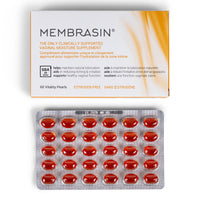Chronic Vaginal Dryness vs. Vaginal Atrophy
When you experience vaginal discomfort, you learn a glossary of new terms that you may have never heard of before. Two of the most common are chronic vaginal dryness and vaginal atrophy. These conditions have some similarities, but it’s important to distinguish between the two, so you can better understand what may be causing distress down there. Below, find out about the differences between vaginal dryness and vaginal atrophy.
Vaginal Atrophy (Atrophic Vaginitis)
Vaginal atrophy is an overarching medical condition that often occurs during or after menopause. Here’s where it gets technical: vaginal atrophy includes the symptom of vaginal dryness, but it also encompasses other issues such as your vaginal walls becoming thinner and inflamed. Sometimes, additional symptoms occur during urination, too, which is why the condition is occasionally called genitourinary syndrome of menopause. You can tell that your vaginal skin has become inflamed if it’s swollen and irritated, but to find out if your vaginal walls are thinning typically requires a pelvic examination by your gynecologist.
Another difference between vaginal atrophy and vaginal dryness is that atrophy is caused primarily by one thing: a drop in estrogen production. That drop in estrogen typically comes from menopause, but cancer treatments, removal of the ovaries, and other conditions can also cause a decrease in estrogen. Treatments for vaginal atrophy typically include hormone replacement therapy such as synthetic estrogen creams. However, women whose vaginal atrophy is caused by hormone-dependent cancer will not be able to use treatments containing estrogen or progesterone, since this can increase the risk of cancer.
Basically, vaginal atrophy is vaginal dryness and then some. And unfortunately, since vaginal atrophy is so frequently a part of the natural aging process, many women do not report it, in which case it’s never treated.
Though vaginal dryness is just one symptom, many other symptoms are sometimes associated with chronic vaginal dryness. For instance, itchiness, burning, and pain during intercourse are often the result of chronic vaginal dryness. Vaginal dryness can strike at any time: about 17% of women from ages 18-50 have experienced it. When menopause begins, that number increases quite a bit.
Vaginal dryness, unlike vaginal atrophy, is caused by a number of different factors. The factors that cause vaginal atrophy can also cause vaginal dryness; but so can childbirth, breastfeeding, cigarette smoking, certain birth control methods, depression, dehydration, and even vigorous exercise. But, no one has to suffer from vaginal dryness, even if only for a few months. Typical treatments include estrogen replacement, lubricants, or a change in lifestyle, depending on what’s causing the issue.
Relieving Chronic Vaginal Dryness and Vaginal Atrophy
Estrogen is the most common solution to these problems, though it doesn’t come without risk. Those who can take estrogen may face an increase in endometrial or breast cancer with long-term use. Fortunately, hormone-free options like Membrasin® are available.
Membrasin® with SBA24™ employs a two-step combination to help combat chronic vaginal dryness or vaginal atrophy. SBA24™ is clinically supported to help maintain natural vaginal moisture. Clinical research showed evidence that SBA24™ improved the integrity of the vaginal lining by 50% and had twice as much improvement in dryness as the group who took a placebo. That means that whether you suffer from chronic vaginal dryness or vaginal atrophy, you can try the hormone-free Membrasin® 2-Step Starter Pack to help support your natural vaginal moisture from the inside and the outside.



